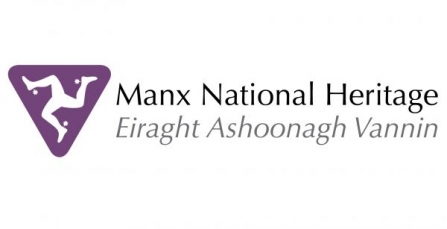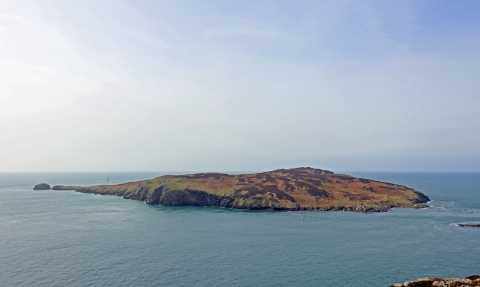
Graham Makepeace-Warne
The Calf of Man Bird Observatory
The Calf of Man is a small island off the south coast of the Isle of Man owned by the Manx Museum & National Trust (trading Manx National Heritage); it is of international importance to wildlife. The Bird Observatory houses a team of Manx Wildlife Trust wardens and volunteers who run a number of projects to record and conserve a wide range of native wildlife. The waters surrounding the Calf of Man are also of international importance for their birdlife and marine mammals and are under statutory protection as the Calf of Man & Wart Bank Marine Nature Reserve.
For a great introduction to life as a Calf of Man Warden, please see Chloe Hurst's video blog comprising 17 episodes: Life on a Remote Island - Calf of Man - YouTube. Chloe was our Estate Warden in 2022 & 2024. You can also watch the 2025 Guy Martin documentary on the Calf Stream Guy Martin: Proper Jobs Series & Episodes | Watch on U (Season 1, Episode 2). The Calf also has a Facebook page: Calf of Man Bird Observatory | Facebook.
Since 2018, the daily ornithology log is uploaded each evening to Trektellen, and can be viewed here; [Trektellen.org] - Migration counts & captures. A monthly report on ornithological highlights (covering the whole Isle of Man, and the Calf from March through to November) is also available here: MOS monthly bird sightings - Biosphere.
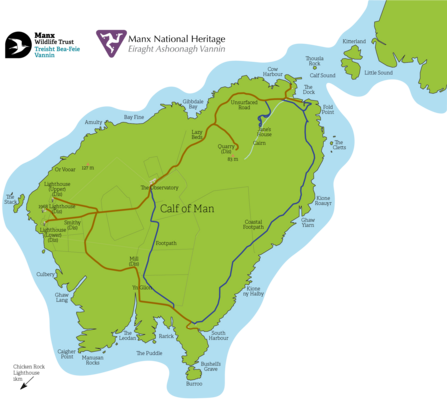
What we do
Bird Ringing
Birds are fascinating creatures and one of the great mysteries is their seasonal movements. Swallows appear in the summer months and according to Manx folklore, hibernate in the mud of ponds during the winter – we now know that they migrate south to the warmer climate of South Africa! This is thanks to bird ringing, which has solved many of these mysteries, although there is still much to learn and uncover.
Since 1959, bird ringing has been carried out on the Calf with over 275,000 birds, of 184 species, ringed by the start of the 2020 season. The birds are trapped in fine mist nets or Heligoland traps and brought to the observatory's ringing room in cloth bags. With all ringing activities, the safety of the bird always comes first. The nets and traps are checked regularly by experienced ringers who have undergone considerable training. This is so they are able to remove birds from the nets and traps and process them quickly and safely so they can be released unharmed. If you find a net or trap with birds in it, please do not attempt to take them out as a ringer will be nearby.
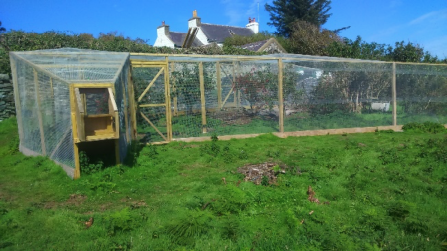
A Heligoland Trap - originally developed in Germany, these traps are a common feature at Bird Observatories
Once the bird has been fitted with the appropriate sized ring, it is aged, sexed, measurements of its wing and weight are recorded and an assessment of its overall health is gained from looking at the amount of fat and muscle the bird has. This process only takes a minute or two and the bird can then be released on its way again.
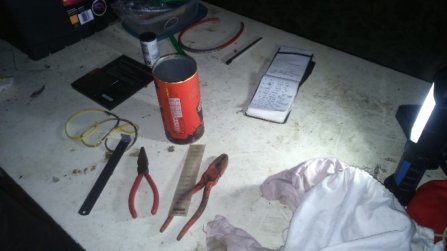
Ringing Equipment
Bird rings come in all different shapes and sizes and are designed to fit comfortably on a bird’s leg – it is like us wearing a wristwatch. The weight of the ring is tiny in relation to their daily fluctuations in body weight, which may vary by 10% or more! Each ring has a return address and a unique number that identifies the individual bird so, if you find a bird with a ring on, or see a bird with colour rings, you can help our research by sending details to the Ringing Scheme.(https://app.bto.org/euring/lang/pages/rings.jsp)
The reasons for ringing birds have changed over time, with the initial focus to find out where birds went. Today the focus of bird ringing is to monitor bird populations and understand reasons for population changes. However, many questions about migration remain unanswered and even now we lack basic information on both the routes and destinations of some of our common migrants. The journey between breeding and wintering sites is often long and arduous and without proper preparation and regular stops for food, many birds will die. The routes taken differ between species, as do their migration strategies. The patterns of migration are also changing and Fig 1 shows the average spring arrival dates of Blackcaps recorded on the Calf between 1959 and 2018. The graph illustrates earlier spring arrivals at a rate of approximately 1 week for each decade.

Figure 1- Blackcap Average Spring Arrival Dates
Aron on bird ringing on the Calf of Man (https://youtu.be/AOaDKb0khaM)
Aron on bird ringing on the Calf of Man
Part of the core function of the MWT wardens on the Calf of Man is to record passing migrating birds and ring them with a unique identification number. The data created, if the bird is recorded again at a later date elsewhere, is invaluable. We have learnt not only the different species that visit the Calf of Man over the years but also, in some cases, where they travel to during the rest of the year.
Ringing gull chicks on the Calf of Man (https://youtu.be/J9yd6yUNya0)
Ringing gull chicks on the Calf of Man
Unlike the small garden birds which are caught in mist nets, gull chicks must be rounded up and ringed whilst still flightless as chicks. It can be a noisy, messy business. In this video Aron, the MWT Bird Warden, is helped by Rob, the Assistant Warden, and a visiting team from MWT HQ.
Below is a short article on Calf recoveries written by Mike Haigh. This report details the work and results from the ringing data collation that we have been working on over the past couple of seasons.
Calf Of Man Bird List
Breeding Bird Surveys
Searching for breeding seabirds on the Calf with Aron (https://youtu.be/Rf4sA1MPtPI)
Searching for breeding seabirds on the Calf with Aron
When time allows, the MWT Bird Warden will scan the coastline of the Calf of Man looking for breeding seabirds. Here we see a few of the birds that Aron saw one day early in July 2020.
Moth trapping
Moth trapping on the Calf of Man with Aron (https://youtu.be/rPO-quv_0v0)
Moth trapping on the Calf of Man with Aron
The MWT managed Bird Observatory on the Calf of Man does much more than record the bird life in and around the islet. On many nights during the summer the wardens will put out a moth light trap then, in the morning, they record the different species before releasing them.
Calf seal survey
Seal Survey volunteers (https://www.youtube.com/watch?v=eFxaYSMghcA)
Calf seal survey volunteers 2020
Our MWT seal survey volunteers on the Calf of Man give an update on how the 2020 season is going and how they are finding their time working on the Calf!
Every year 2 volunteers go to the Calf of Man to survey the seal pup numbers so MWT can record and monitor seal populations and breading.
They also photo ID older seals which get compared to other databases, watching for overlap within other photo ID records in the Irish sea and further afield!
Bird Observatories Council
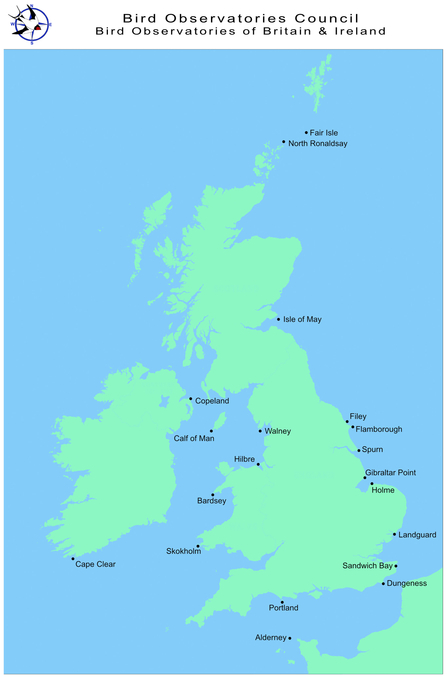
View larger version here.
The Calf of Man Bird Observatory is a Bird Observatory Council (BOC) accredited bird observatory. The map to the left shows all the BOC accredited bird observatories of Britain and Island.
The BOC co-ordinates and promotes the work of the bird observatories at a national level. Individual observatories, like the Calf, are accredited to the Council when they meet specified criteria relating to activities and facilities, the list of which can be found here.
The Calf Observatory contributes to the annual BOC newsletter with reports from the season. You can find previous reports below.
Butterfly Census
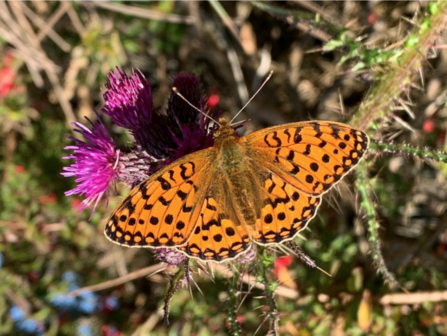
Dark Green Fritillary, photographed on the Calf by Rob Fisher.
The recording of butterflies on the Calf was rather sporadic during the first 25 years of the Bird Observatories history, however since 1984 more detailed records have been maintained. Since 2006, a formalised butterfly survey has been undertaken, although this was modified and shortened in 2018, following difficulties experienced in completing the monthly survey.
A total of just 20 species have been confirmed as recorded, with 11 of these considered to be either common or abundant. Of the other nine species, Wall, Grayling and Small Heath have small resident populations but are uncommonly recorded, Clouded Yellow occur irregularly as migrants, whilst Orange-tip, Speckled Wood, Comma and Monarch are rare visitors.
Have a look at the collated report below!
Other non-avian records

Migrant Hawker, photographed on the Calf by Daniel Woollard
The recording of the Odonata (dragonflies and damselflies) occurring on the Calf has been undertaken annually since 1978 and reported in the Calf of Man Bird Observatory reports. Since 2005 digital records have been maintained and this has led to a more detailed keeping of the records and the numbers of each species.
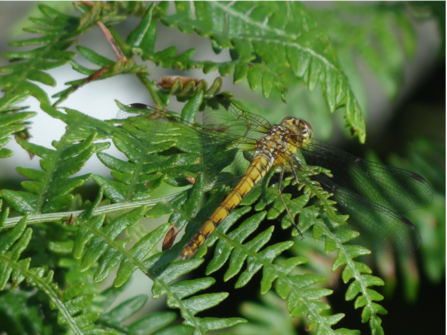
Common Darter, photographed on the Calf by Daniel Woollard.
A total of just 11 species have been confirmed as occurring on the Calf, with Blue-tailed Damselfly and Common Darter being the most regular and numerous of those species seen. Most records come from the Millpond / Withy area, although during autumn, dragonflies, particularly Migrant Hawker, are frequently seen hunting around the Observatory gardens. There are in addition, several small ephemeral ponds located at various places around the islet, which are likely to host Odonata; these are infrequently visited by wardens or anyone specifically looking for these insects and it is likely that most species are under-recorded.
Undoubtedly, a more systematic approach to looking for dragonflies and damselflies would increase our understanding of the status of several species, as well as likely adding species not yet seen on the Calf. Several species occur commonly on the main Island, but which are yet to be recorded on the Calf of Man.
Have a look at the report below!
Results
The population of Manx shearwaters on the Calf of Man was decimated through predation by invasive species. Manx Wildlife Trust wardens at the Calf of Man Bird Observatory are running a long term project to help bring them back. Bird Warden, Aron Sapsford, shows us more about how they are doing it.
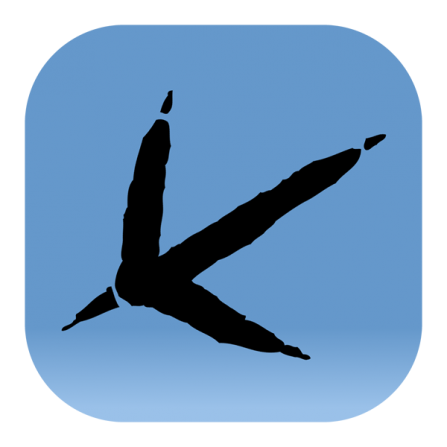
The Calf of Man Bird Observatory sends all of its bird recording data to BirdTrack, a project that looks at migration movements and distributions of birds throughout Britain and Ireland. The data is contributed to the British Trust for Ornithology (BTO) science.
BirdTrack provides facilities for observers to store and manage their own personal records; it also uses these to support species conservation at local, regional, national and international levels. More at www.birdtrack.net.
Staying on the Calf
During the open season, there are regular boat trips to the Calf from Port St Mary and Port Erin, for day visits, which are dependant on both the tide and weather conditions. The Calf of Man and the Bird Observatory are owned by Manx National Heritage. It is possible to book overnight stays by visiting Self Catering Hostel - Calf of Man : Manx National Heritage
Get involved
We have a range of volunteering opportunities on the Calf of Man. To find out more:
Call us on 01624 844432
Or fill in a Volunteer Registration Form.
We also advertise specific jobs and volunteering roles on the ‘Jobs’ page.

